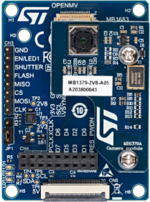This article explains how to get started on the Face Recognition application running on STM32 microcontroller.
This article provides an overview on the following topics:
- Overview of the required hardware setup
- Overview of the software architecture
- Description of the Face Reco application running on STM32
1. Hardware setup
The Face Reco application is running on a hardware setup made up of a STM32 microcontroller board connected to a camera module board.
1.1. STM32 board: STM32H747 Discovery Kit
The STM32H747I-DISCO is a complete demonstration and development platform for STMicroelectronics STM32H747XIH6 microcontroller, designed to simplify user application development. The STM32H747XIH6device is based on the high-performance Arm® Cortex®-M7 and Cortex®-M4 32-bit RISC cores. The Cortex®-M7 core operates at up to 480 MHz and the Cortex®-M4 core at up to 240 MHz.
The STM32H747XIH6device incorporates high-speed embedded memories with a dual-bank Flash memory of 2 Mbytes and of 1 Mbyte of RAM.
The other key specifications of the board are:
- On-board STLINK-V3E debugger/programmer
- USB OTG HS
- 4” capacitive touch LCD display module with MIPI® DSI interface
- 2 x 512-Mbit Quad-SPI NOR Flash memory
- 256-Mbit SDRAM
- 8-bit camera connector
- microSD™ card
1.2. Camera board
Two camera module boards are supported:
1.2.1. STM32F4DIS-CAM camera module
1.2.2. B-CAMS-OMV based camera module
The picture below shows the B-CAMS-OMV mother board on which a MB1379 camera daughterboard is plugged:
The B-CAMS-OMV board is an adaptation which, on top of MB1379 camera daughterboard , enables to support camera board from OpenMV and Arducam.
2. Software architecture
3. Description of Face Reco demo application
Run in internal memory FPS@3.5 Default threshold so to have 1% FAR Threshold configurable via "Change Setings" menu etc..
